Testimony of Andrew Pallotta, Executive Vice President, New York State United Teachers, to the Senate Finance Committee, John DeFrancisco, Chair, and Assembly Ways and Means Committee, Herman D. Farrell, Jr., Chair, on the Proposed 2014-15 Executive Budget for Higher Education
February 6, 2014
Senator DeFrancisco, Assemblyman Farrell, honorable members of the legislature and distinguished staff, I am Andrew Pallotta, Executive Vice President of New York State United Teachers (NYSUT). NYSUT represents more than 600,000 teachers, school-related professionals, academic and professional faculty in higher education, professionals in education, in health care and retirees statewide.
Thank you for the opportunity to testify today on the proposed 2014-15 Executive Budget for Higher Education. My testimony represents the concerns of over 75,000 faculty and professional staff who work in colleges and universities across New York State. These include the members of United University Professions at the State University of New York, the Professional Staff Congress of the City University of New York and the faculty and staff at nearly all the SUNY community colleges in this state.
I am joined today by Dr. Frederick Kowal, President of United University Professions (UUP), and by Dr. Barbara Bowen, President of the Professional Staff Congress (PSC). You will hear from both Dr. Kowal and Dr. Bowen in a few moments.
Let me begin by making a few comments regarding the importance of public higher education. It is abundantly clear that obtaining a college degree is no longer just a laudable goal, it's a necessity. It is a prerequisite for the vast majority of employers today. It is also clear, that the cost of higher education is becoming out of reach for far too many families. In fact, student debt has now surpassed credit card debt in this country.
SUNY and CUNY are literally the only options for hundreds of thousands of students to obtain a college education. Our public higher education systems in this state and nation are the great equalizers of the twenty-first century. Yet, we continually underfund these institutions. Over the last five years, our public higher education institutions have been cut by nearly $2 billion. This has put our public colleges and universities under intense pressure to eliminate programs and courses, erode quality and slash opportunities for students in need. Public higher education's mission of teaching, research and health care is the key to a bright future for all New Yorkers.
NYSUT and its higher education affiliates ask that you support our "Public Higher Education Quality Initiative." This initiative calls on the state to:
- Increase funding for SUNY and CUNY four-year campuses and raise community college base aid to reverse the deep decline in funding over recent years. We must invest in the gateway to economic quality that public higher education provides
- Create an endowment to restore and rebuild SUNY and CUNY academic departments through the hiring of additional full-time faculty and professional staff. This will help to ensure quality courses, programs and mentoring that our students deserve
- Invest strongly in student financial aid and opportunity programs, update and reform the state's Tuition Assistance Program to advance a strong system of public higher education that ensures quality, access and opportunity for all
Increase Funding to Public Higher Education Institutions
The 2014-15 Executive Budget essentially holds year-over-year funding levels flat for SUNY, CUNY and the community colleges. If the Executive Budget proposed level of funding to our four-year campuses is adopted, it will be the third straight year of flat funding to these campuses. It is important to point out that flat funding equates to a cut as mandatory costs increase from year to year. Moreover, the flat funding in recent years was preceded by two years of draconian cuts during the Great Recession.
Furthermore, if you look at the percentage of state support that makes up SUNY's and CUNY's total operating budgets, you will see that it has fallen significantly over time as the charts below illustrate. For SUNY, state support in 2002-03 constituted 63 percent of SUNY's operating budget with 37 percent coming from other retained revenues specifically, student tuition and fees. By 2012-13, we experienced a complete reversal with only 37 percent of SUNY's operating budget coming from state support and 63 percent coming from revenue primarily generated from students.
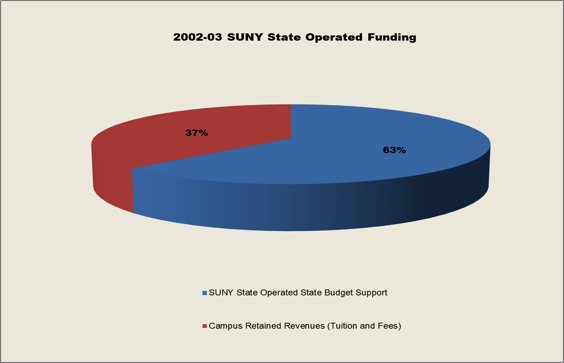
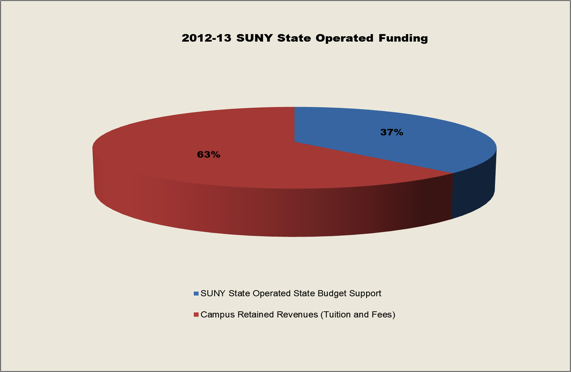
For CUNY, the story is very similar. In 2002-03, state support constituted 61 percent of its total operating budget with 36 percent coming from other revenues and three percent coming from the city of New York. By 2012-13, state support dropped to only 52 percent with 46 percent coming from other revenues and two percent from the city of New York.
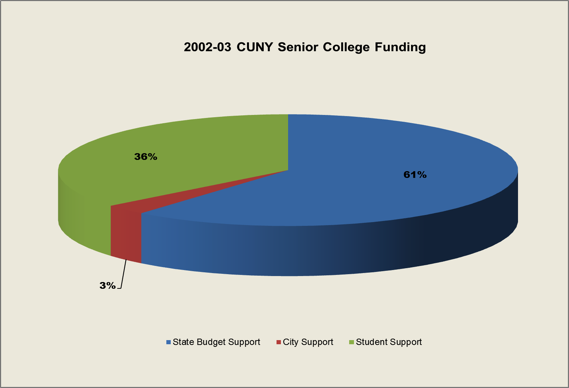
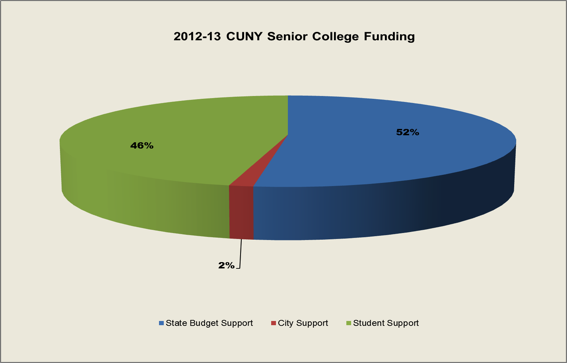
As you can see, over time we have steadily increased our reliance on student tuition revenue for operating expenses at SUNY and CUNY. In fact, our students are now funding the annual increases in operating costs at SUNY and CUNY four-year campuses through mandated yearly tuition increases. This has to change. Funding public higher education has to be a priority in this state. We know that in relative terms, a small amount of funding goes a long way in higher education. We ask that you make a commitment to begin replacing state operating aid to SUNY and CUNY four-year campuses that has been lost from 2007-08 funding levels.
With respect to community college funding, we thank you for increasing community college base aid the last two years by $150 per full-time equivalent student. This has helped our campuses maintain current levels of academic programs and services offered to students. While we appreciate these efforts, we are still far below 2008-09 state funding levels for these campuses. As the charts below illustrate, both SUNY and CUNY community college students are paying the lion share of operating costs of these campuses.
In fact, over the ten year period from 2002-03 to 2012-13, SUNY community college students went from paying 37 percent of the operating costs to 44 percent. At the same time, the state's contribution for these costs went from 32 percent to 26 percent with the local sponsor's share remaining fairly constant at 32 percent and 31 percent, respectively.
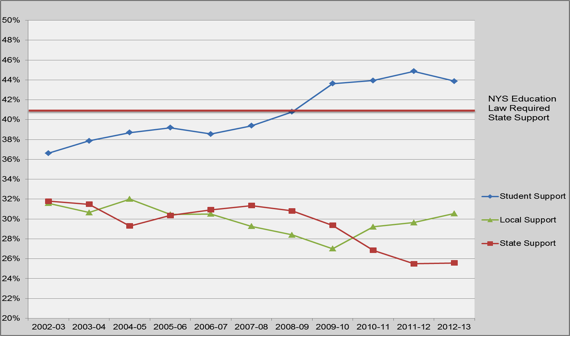
When you look at CUNY's community colleges during the same time period, we see the same story. The student share went up from 35 percent to 43 percent while the state share went down from 33 percent to 25 percent. The local share increased by one percent from 31 percent to 32 percent.
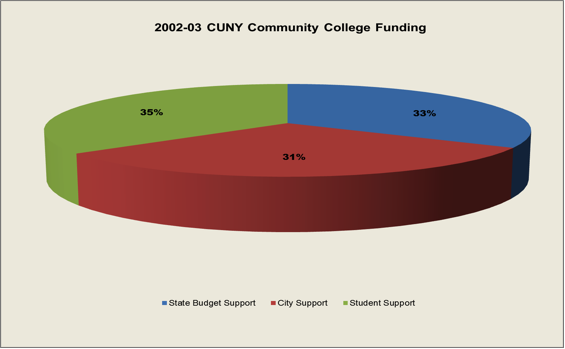
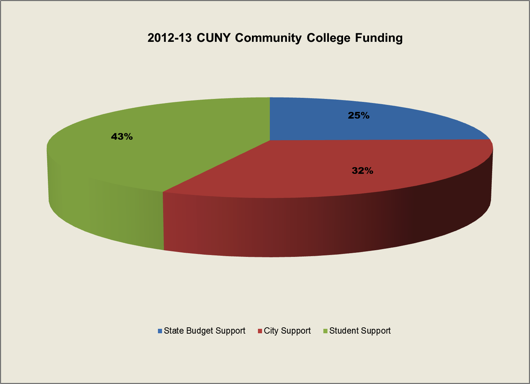
The main point here is that the state is not living up to its statutory obligation of providing 40 percent of the operating costs to these institutions. In fact, it has never lived up to this obligation and the burden of funding these institutions has been primarily placed on our students. Therefore, NYSUT requests that an increase of $250 per FTE student be provided in this year's budget to get us essentially back to 2008-09 funding levels for these campuses. This increased funding should obviate the need for an increase in tuition, which our students cannot afford.
Public Higher Education Endowment
The loss of state funding and the overreliance on tuition to fund our public higher education institutions has had a dramatic impact on our full-time faculty to part-time faculty ratios. The declining cadre of full-time faculty has long been a concern for NYSUT, our higher education affiliates and students.
The percentage of full-time faculty at SUNY's state-operated campuses (2012-13) is only 44 percent while 56 percent are part-time. For CUNY system-wide (2012-13), the percentage of full-time faculty is 40 percent while the percentage of part-time faculty is 60 percent. At our SUNY community colleges it's even worse. The percentage of full-time faculty at SUNY community colleges is 21 percent while the part-time percentage is 79 percent.
NYSUT, and its higher education affiliates, are calling on the state to establish an endowment for the sole purpose of hiring additional full-time faculty and professional staff at SUNY, CUNY and their community colleges. The ultimate goal of this endowment is for SUNY and CUNY to achieve a 70 percent to 30 percent full-time to part-time faculty ratio which will enhance the quality of academic programs and services offered to students. As part of this endowment proposal, we want to ensure that current part-time faculty members are given preferable consideration to filling new full-time faculty lines. The process for hiring additional full-time faculty and professional staff should be done through labor/management collaboration.
We have great faculty at our public higher education institutions. The fact of the matter is we have also lost a lot of great faculty to other universities across this country. If our state is going to be competitive in the global information economy it is imperative that we rebuild our academic departments at both SUNY and CUNY. If we are serious about revitalizing the upstate economy through the START-UP NY program, we need to invest in intellectual capital. In the new economy, innovative and high-tech businesses are locating around colleges and universities that employ the best and brightest faculty.
The fact is annual tuition increases are not an adequate source of revenue to enhance full-time faculty and professional staff lines. As tuition rises, so too does the student tuition tax credit that SUNY and CUNY must self-fund out of their existing budgets. In other words, the net revenue derived from annual tuition increases is shrinking every year and is therefore not sustainable. Moreover, NY SUNY 2020 is due to sunset after next year. An endowment provides long-term financial stability in providing the annual resources needed to enhance our academic departments.
Other state university systems have significant endowments which puts them at a distinct advantage over our state. Below is a just a sampling of some of those endowments.
| U. Of Texas system |
$17.1 billion
|
| U. Of Michigan - Ann Arbor |
$7.6 billion
|
| Texas A&M |
$7.0 billion
|
| U. Of Minnesota |
$2.5 billion
|
|
Ohio State University |
$2.2 billion
|
| U. Of Washington |
$2.1 billion
|
| U. Of Wisconsin- Madison |
$1.9 billion
|
| Penn. State |
$1.7 billion
|
| U. Of Indiana system |
$1.6 billion
|
| Michigan State U. |
$1.4 billion
|
| U. Of Florida |
$1.3 billion
|
| U. Of Kansas |
$1.3 billion
|
| U. Of Nebraska |
$1.3 billion
|
| U. Of Oklahoma |
$1.3 billion
|
| State University of New York (as a system) |
$ 0 |
As you can see, we have a lot of catching up to do. We ask that we start the funding for this critical initiative in this year's budget. We envision the funding for this endowment to be phased in over three years (at least $250 million per year). Assuming an 8 percent annual return on investment, the endowment would generate the following interest:
- $250 million would generate $20 million
- $500 million would generate $40 million
- $750 million would generate $60 million
The source of funding for this endowment can be secured in a variety of ways, or a combination of ways, including but not limited to:
- Issuing Bonds through the Dormitory Authority
- Casino Licensing Fees – Currently, the only revenue NYS will garner from the establishment of Las Vegas style casinos is a percentage of the revenue generated by such casinos We propose that the state charge a one-time licensing fee to the corporations that will operate casinos in this state. The University of Maryland conducted a recent study that found that the licensing fees for the establishment of casinos in Maryland were worth, at a minimum, $500 million each. We believe they are worth even more in this state given our size compared to Maryland.
- Securitizing the Future Growth of Gaming Revenue
- Campus Impact Fees for the START-UP NY Program. We propose that a one-time impact fee for each campus be charged to corporations and businesses that participate in the START-UP NY program This fee should be a reasonable amount so as to not deter program participation The revenue generated from these fees would be allocated to the endowment. We believe that a campus impact fee is warranted given that participants of this program will benefit generously from state tax exemptions. Moreover, the state's concerted effort to rebuild academic departments at SUNY and CUNY through this endowment, will enhance academic quality and therefore enhance the reputation of these institutions This will help to attract and retain participation in this program.
- Private Donations
Attracting and retaining the best and brightest scholars entails competing not only against other colleges and universities across the country, but against higher education institutions across the world. Again, if we are serious about competing for intellectual capital to attract innovative and high-tech businesses to our state, we need to create this endowment this year.
SUNY Hospitals
I would now like to talk about a critical issue for us which is the funding for our SUNY hospitals. State support for SUNY's hospitals was created more than 20 years ago to recognize that New York has a responsibility to at least partially compensate the hospitals for their service to indigent populations. While the Executive Budget provides an increase of $9 million in General Fund appropriations, this amount of funding is still $19 million below the overall spending authority enacted in last year's budget.
SUNY hospitals provide unique life-saving services not typically provided in private hospitals. These include burn units, trauma care units and poison control. They also serve as a safety net for low-income communities, the uninsured and the underinsured. These patients rely on these hospitals for health care.
The simple truth is that our SUNY hospitals cannot carry out their critical public health care and academic missions on this level of state funding. The state needs to make a financial commitment to these hospitals to ensure their survival. We ask that you restore the funding level to these hospitals back to the 2010-11 SFY level of $128 million. These hospitals are in serious financial jeopardy especially, SUNY Downstate.
I urge all of you to do whatever it takes to keep the University Hospital of Brooklyn (Downstate) from closing or being privatized. The Executive Budget again proposes Article VII legislation this year that would establish a pilot program to restructure health care delivery systems. This proposal authorizes the establishment of five business corporations through the public health and planning council – one of which shall be affiliated with an academic medical center or teaching hospital (presumably SUNY Downstate or SUNY Upstate).
The business corporations are also authorized to operate hospitals. If this legislation is adopted, it would set the stage for the closure, or at the very least, the privatization of SUNY Downstate. This cannot be allowed to happen. We strongly urge you to reject this proposal.
Moreover, we strongly urge you to enact our Brooklyn Safety Net Hospital Plan that we have developed with UUP and other unions to address the hospital crisis in Brooklyn. We believe that this plan is the only one that is a win-win for all the hospitals in Brooklyn. We thank the legislature, especially, the Brooklyn delegation for all the support they have provided for SUNY Downstate over the last year and a half. Without this support, we firmly believe SUNY Downstate would have already been privatized or closed. We ask you to continue to fight with us to ensure that this great institution is not allowed to become significantly downsized to become a shell of its former self, as some forces are trying to do. We must keep SUNY Downstate a state-operated, full-service public hospital.
Student Financial Aid and Opportunity Programs
NYSUT urges the legislature to continue to invest in student opportunity programs that provide greater student access and remediation for students in need. We urge you to restore the funding cuts to student opportunity programs such as EOP, SEEK, ASAP and the GAP program.
CUNY's ASAP program is a perfect example of a program that provides results for students. This program has been extremely successful because it provides students with the tools that they need to be successful (e.g. access to comprehensive advisement/mentoring, affordable tuition and financial help).
Finally, NYSUT supports updating the Tuition Assistance Program which is now 40 years old. This wonderful program has afforded so many students the ability to obtain a higher education in this state. It needs to be updated, however, as too many students are now excluded from or underserved by the current program.
Conclusion
In conclusion, we all know that higher education has the power to enable people to reach their full potential and to lift individuals out of poverty. We know how important SUNY and CUNY and their community colleges are to revitalizing our state's economy yet, the state keeps under funding these institutions. It's time to reverse that trend. It's time that we invest in public higher education – our state's path to future prosperity.
Again, thank you for the opportunity to testify today. I will now turn it over to Dr. Kowal who will be followed by Dr. Bowen.
#37046